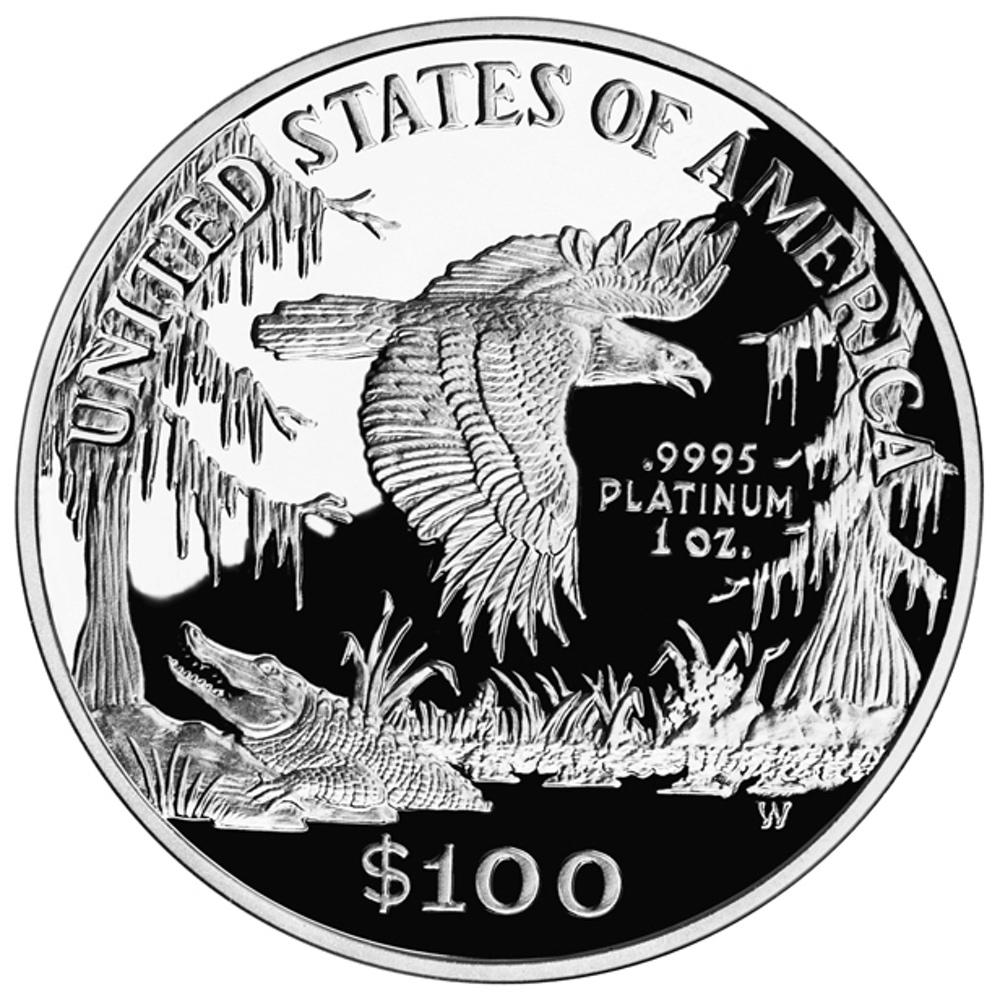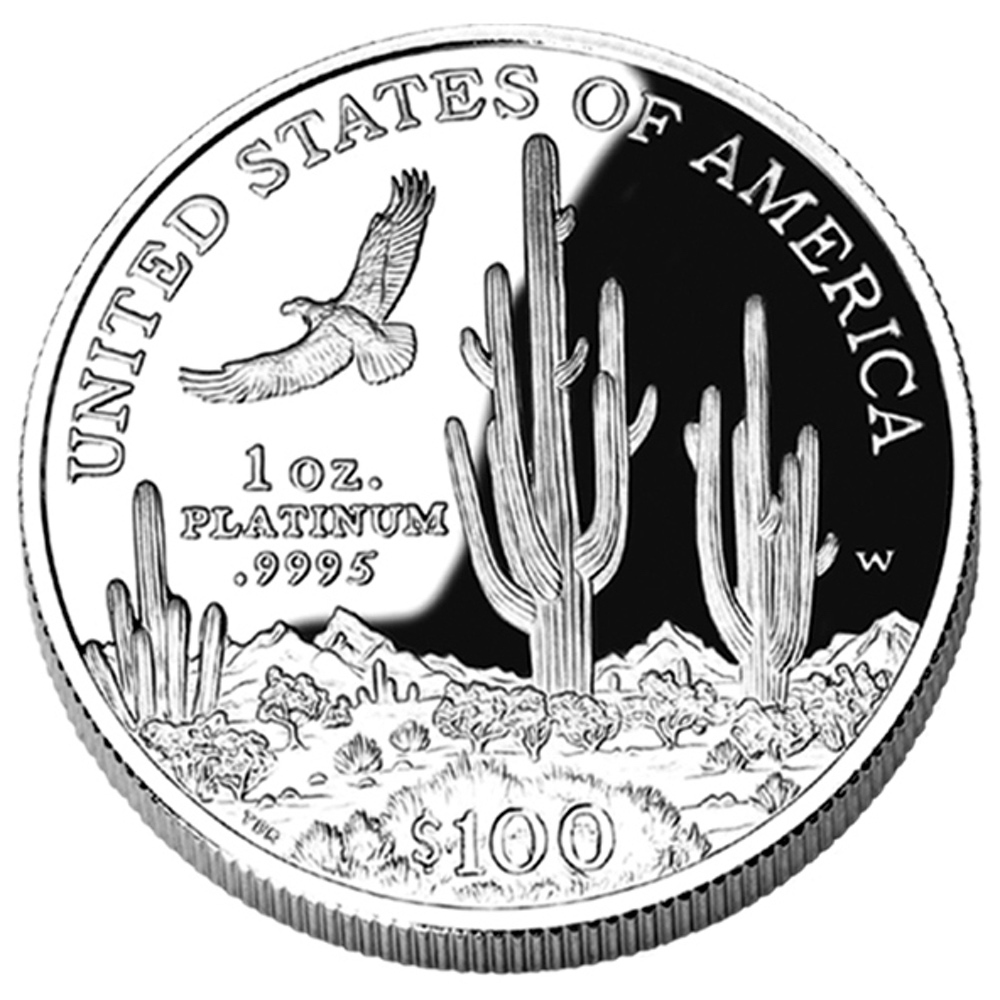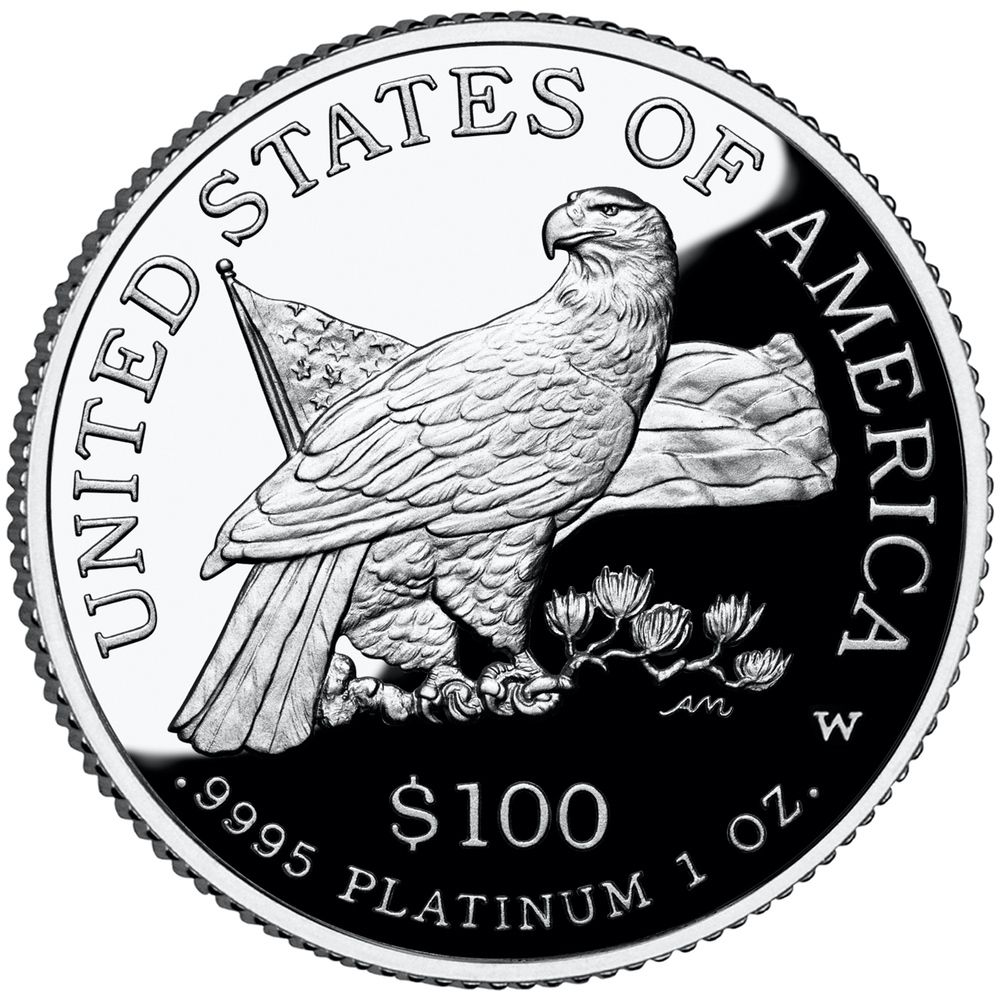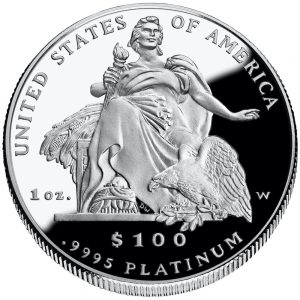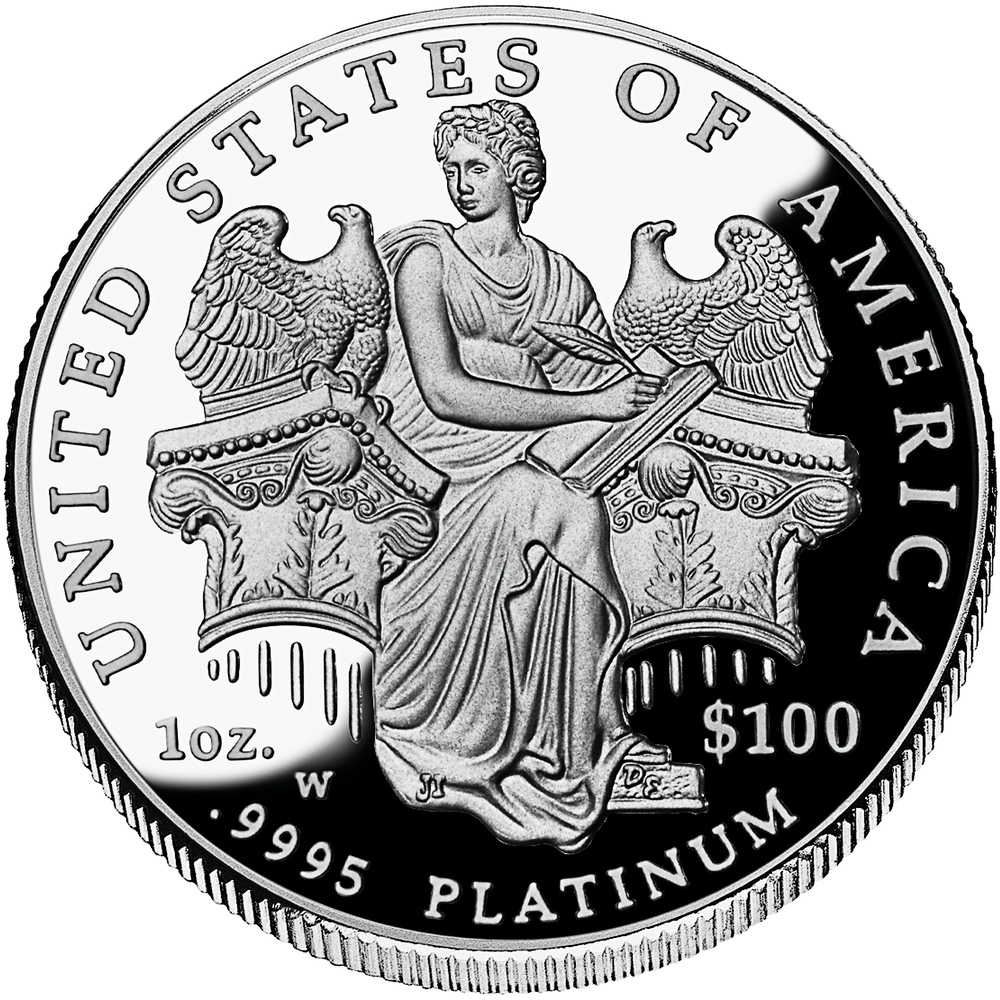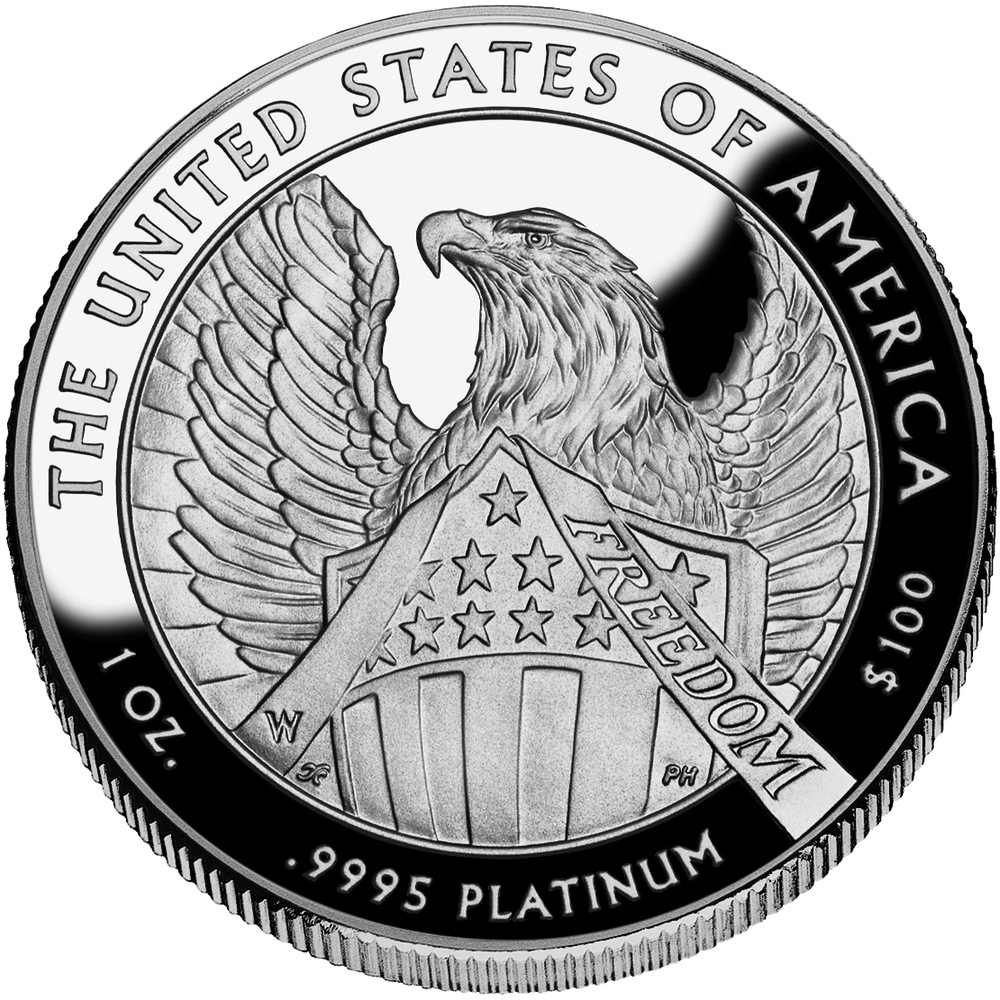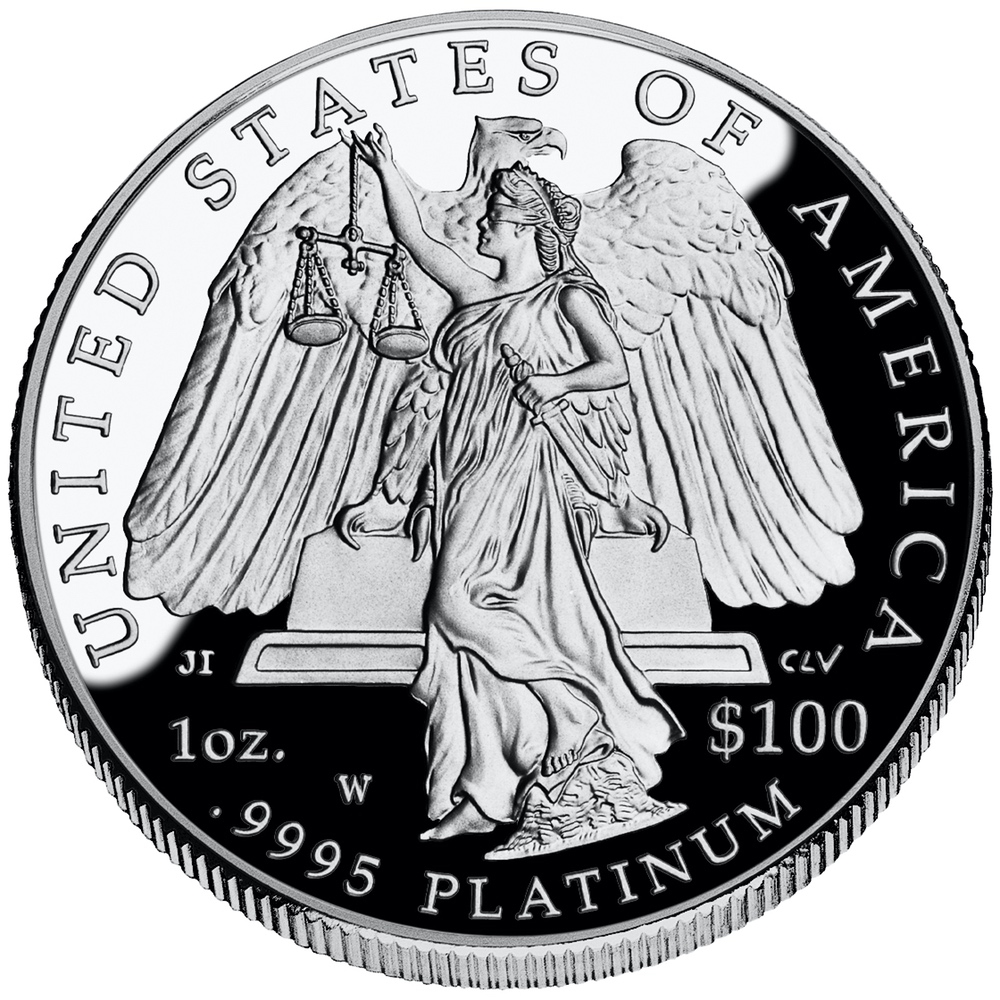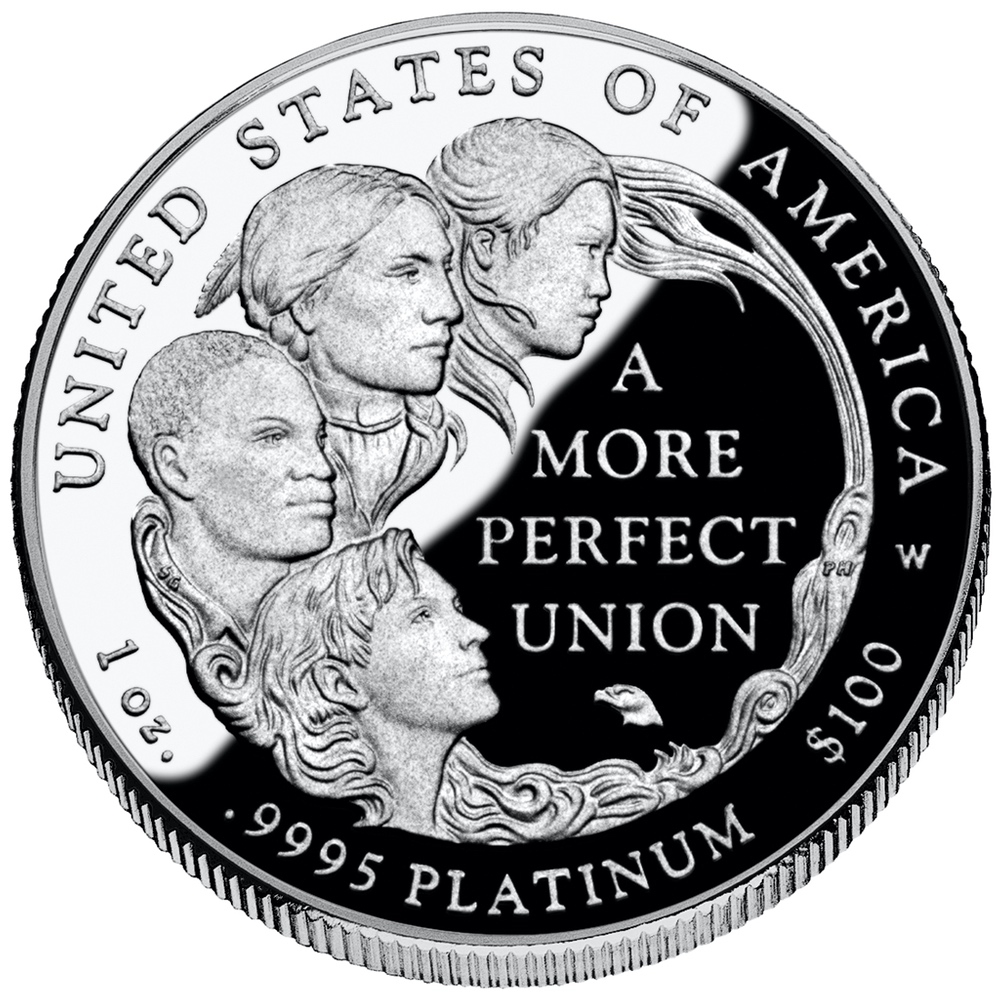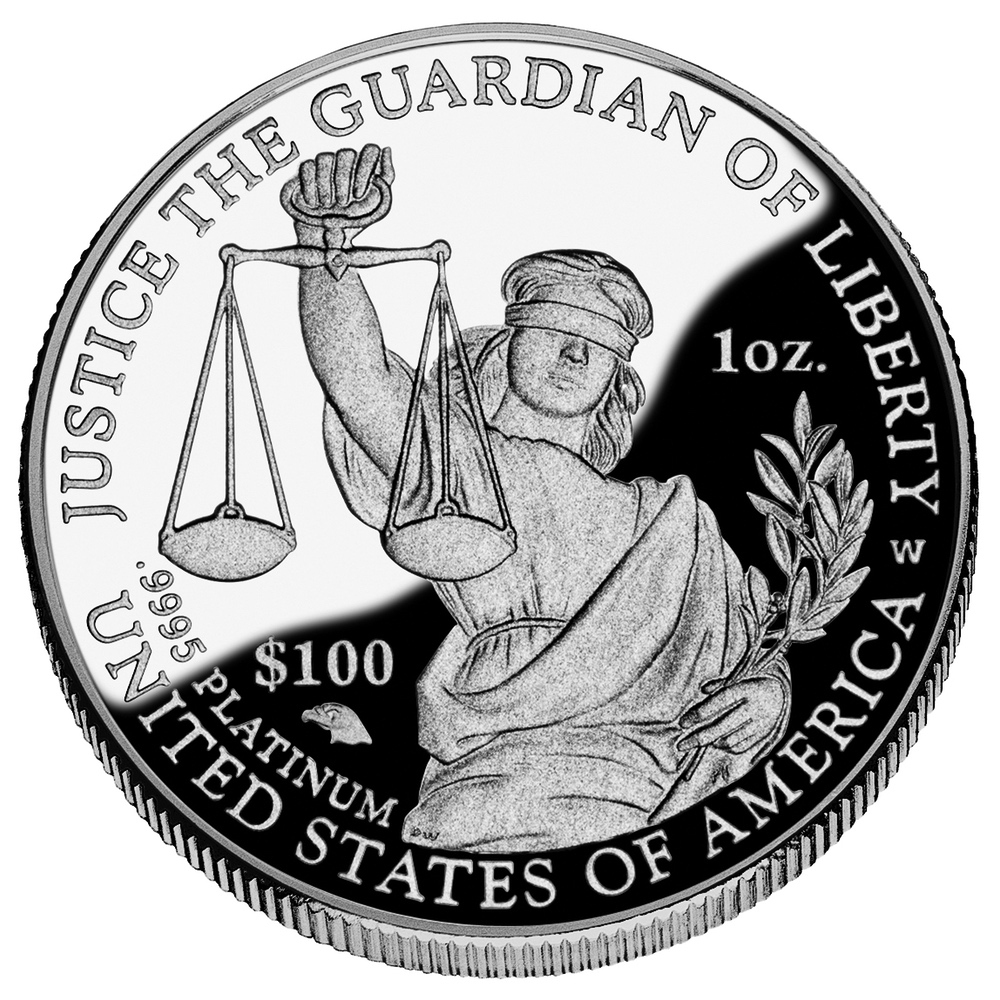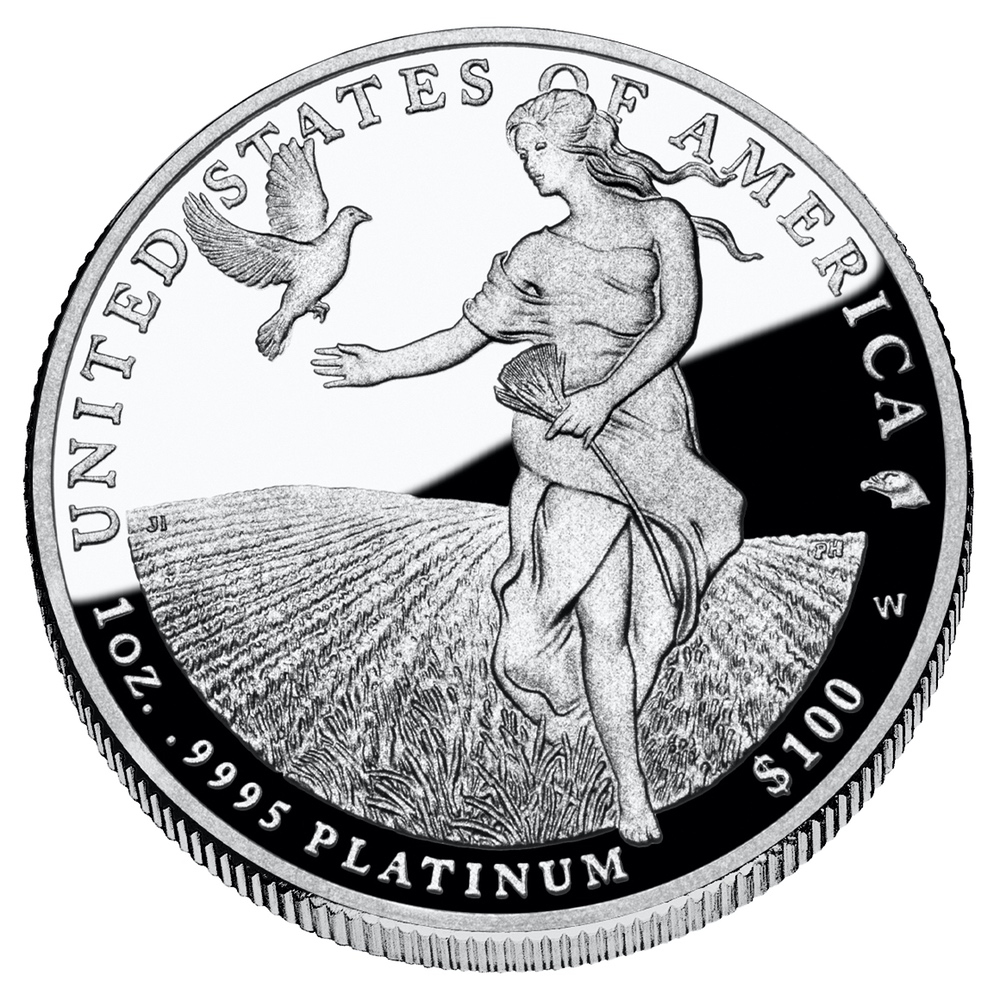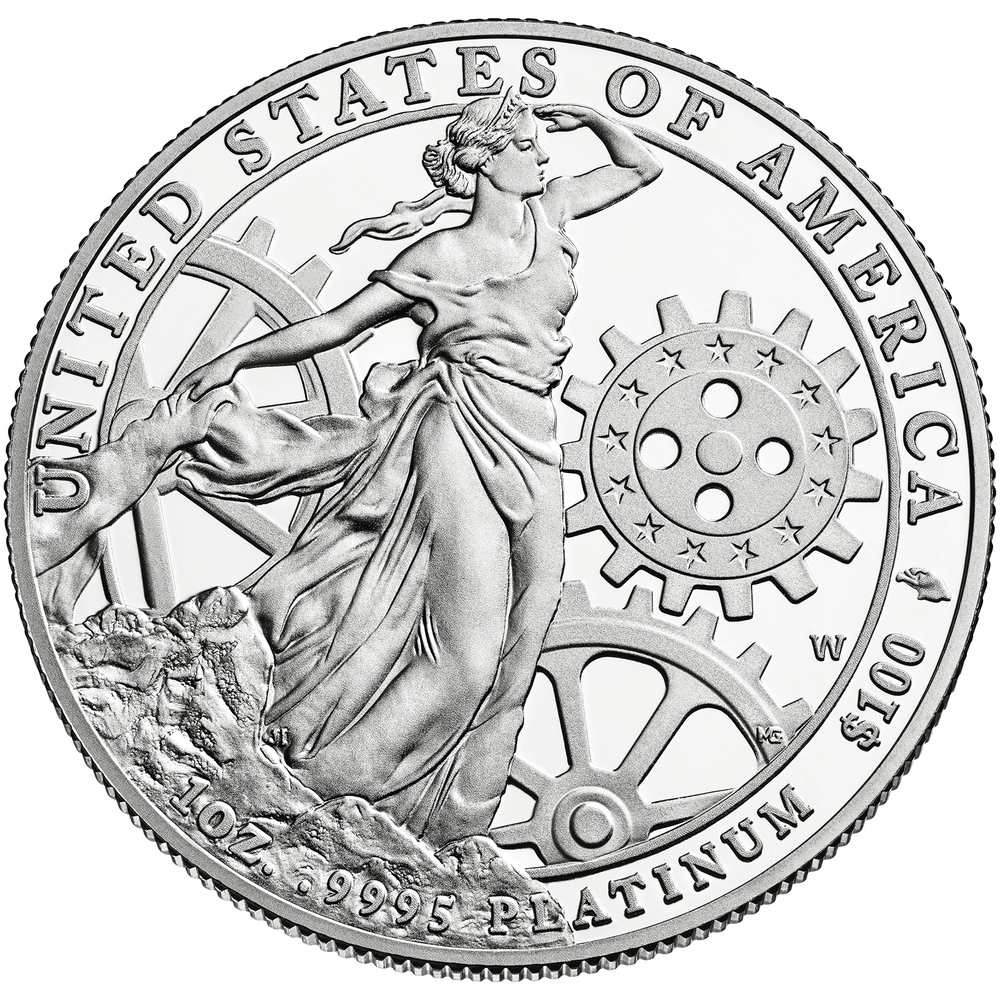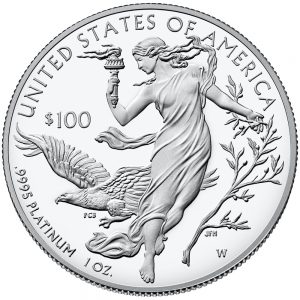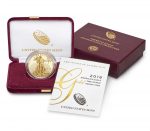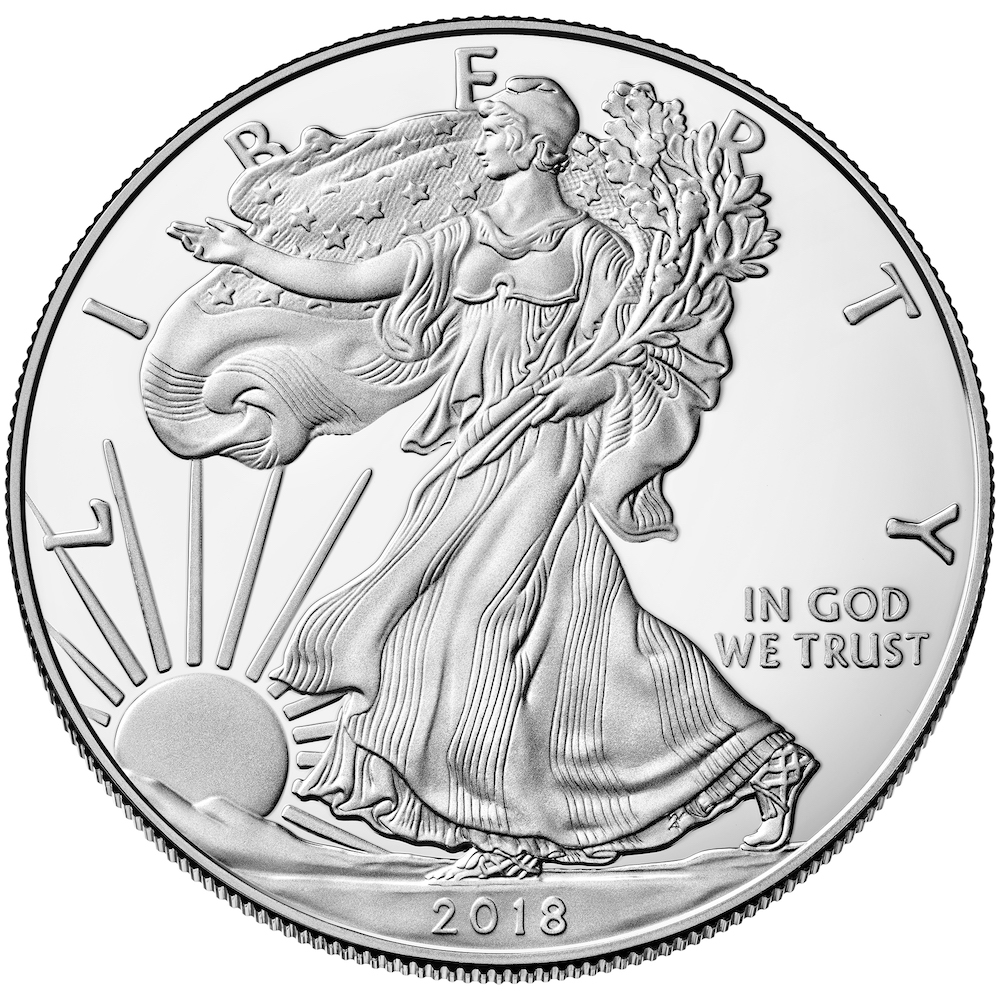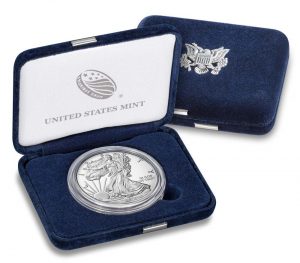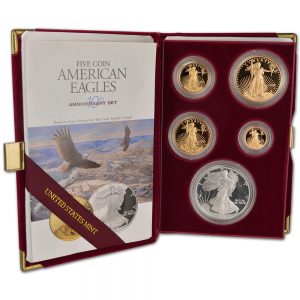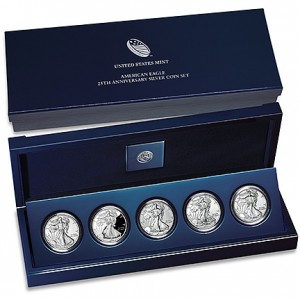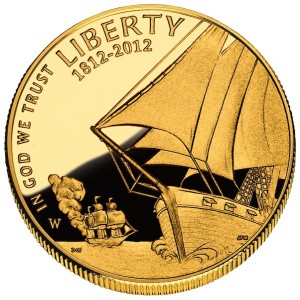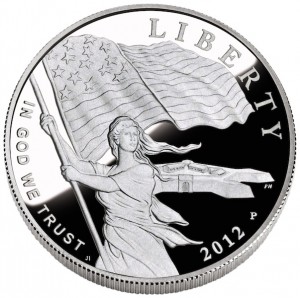U.S. Mint Unveils Negro League Baseball Museum Commemorative
The U.S. Mint and the Negro League Baseball Museum held an unveiling event for the 2022 NLBM Commemorative Coin Program. The ceremony was held at the museum in Kansas City, Missouri. NLBM Director Bob Kendrick hosted the event. Also attending was Sen. Roy Blunt (R-MO), President of the Kansas City Federal Reserve Esther George, and Kansas City Mayor Quentin Lucas (D).
Rep. Emmanuel Cleaver (D-MO) recorded a message for the event because he was traveling overseas. Cleaver was a council member and was an early supporter of the museum. Cleaver continued to support the museum as mayor of Kansas City and was one of the Members of Congress who ushered the bill to authorize the commemorative program to passage.
As part of the ceremony, Sen. Blunt presented a copy of the signed law to the museum. Blount and Cleaver autographed the copy.
Acting Director of the U.S. Mint Ventris Gibson recorded the design unveiling ceremony they played at the museum. Before announcing the designs, Gibson revealed that her father played for a Negro League team in Virginia from 1949 through 1960.
Later in the day, the U.S. Mint published a press release with the design information.
The following are screenshots of the ceremony:
A Look at the American Eagles: The American Platinum Eagles
- American Silver Eagles
- American Gold Eagles
- American Platinum Eagles ← you are here
- American Palladium Eagles
The Platinum American Eagle coins were an addition to the American Eagle bullion program to satisfy the needs of the domestic platinum mining industry. Work to create the program began in 1995 with Platinum Guild International Executive Director Jacques Luben working with Director of the United States Mint Philip N. Diehl and American Numismatic Association President David L. Ganz to pursue the appropriate legislation.
As with a lot of legislation, it was added to an omnibus appropriations bill (Public Law 104-208 in Title V) passed on September 30, 1996. Since the bill was necessary to keep the government functioning, it was signed by President Bill Clinton that same day.
The first platinum coins were issued in 1997.
Platinum American Eagle coins are the only bullion coins struck by the U.S. Mint that use a different reverse design for the proof coins than the uncirculated bullion coins. The reverse of the proof coins featured different themes that have largely gone unnoticed by collectors. Beginning in 2018, the Preamble to the Declaration of Independence series will introduce all new designs for both the obverse and reverse of the proof coin.
American Platinum Eagle Design
The obverse design of the American Platinum Eagle features a front-facing view of the Statue of Liberty from the shoulders designed by John Mercanti. Mercanti also designed the obverse of the 1986 Statue of Liberty Commemorative Silver Dollar.
The reverse features a bald eagle soaring above the earth with a rising sun in the background. It was designed by Thomas D. Rodgers Sr. The reverse also includes the weight of the coin and its denomination.
- Obverse of the American Platinum Eagle coin was designed by John Mercanti
- Reverse of the original American Platinum Eagle and still used on the bullion coins was designed by Thomas D. Rodgers Sr.
The reverse designs of the proof coins were by different artists and discussed below.
American Platinum Eagle Coins are offered in four different sizes with each size being of different legal tender face value. The different coins are as follows:
- One-ounce American Platinum Eagle: $100 face value, is 32.7 mm in diameter, contains one troy ounce of platinum and weighs 1.0005 troy ounces,
- One-half ounce American Platinum Eagle: $50 face value, is 27 mm in diameter, contains 0.5000 troy ounce of platinum and weighs 0.5003 troy ounce,
- One-quarter ounce American Platinum Eagle: $25 face value, is 22 mm in diameter, contains 0.2500 troy ounce of platinum and weighs 0.2501 troy ounce,
- One-tenth ounce American Platinum Eagle: $10 face value, is 16.5 mm in diameter, contains 0.1000 troy ounce of platinum and weighs 0.1001 troy ounce.
All coins are struck with reeded edges.
Each coin is made from .9995 platinum. The composition is comprised of 99.95% platinum and 0.05% of an unspecified metal, likely copper. American Platinum Eagle coins are produced so that each size contains its stated weight in pure platinum. This means that the coins are heavier than their pure platinum weight to account for the other metals in the alloy.
Bullion American Platinum Eagle Coins
The American Platinum Eagle program produces bullion and collectible coins. The bullion coins can be stuck at any branch mint but does not have a mintmark. Bullion coins are sold in bulk to special dealers who then sell it to retailers. They are struck for the investment market.
Although some people do collect bullion coins there are not produced for the collector market. As with other investments, American Platinum Eagle bullion coins are subject to taxes when sold and may be held in Individual Retirement accounts. Please consult your financial advisor or tax professional for the tax implications for your situation.
Bullion coins of all four weights were struck from 1997-2008. Beginning in 2014, the U.S. Mint has only struck the one-ounce $100 American Platinum Eagle for the bullion market.
Collector American Platinum Eagle Coins
Collector coins are produced and sold by the U.S. Mint in specialty packaging directly to the public. Collectors can purchase new coins directly from the U.S. Mint and find these coins online. Collector American Platinum Eagle are different from other coins in the American Eagle series in that every year they are produced the U.S. Mint struck them in different designs and are only available as proof strikes.
In addition to the changing designs, the U.S. Mint sold uncirculated coins with a burnished (satin) finish using the design of the business (bullion) coins were struck 2006-2008 at West Point in all four weights.
The collector American Platinum Eagle may be one of the most under-appreciated series of coins produced by the U.S. Mint. Since its introduction in 1997, the U.S. Mint has produced four series of proof coins with the reverse honoring different aspects of the nation with plans for two more beginning in 2018 and 2021.
What distinguishes these coins are the well-executed reverse designs that few get to see or pay attention. It may be difficult for the average collector to consider collecting these coins because of the price of platinum has been either on par or higher than the price of gold. Also, platinum is not as well regarded as gold or silver as a precious metal causing it to be overlooked.
Following the proof coins issued in 1997 with the design used on the bullion coin, the reverse design has featured the following themes:
- Vistas of Liberty Reverse Designs (1998-2003):
- 1998 Eagle Over New England
- 1999 Eagle Above Southeastern Wetlands
- 2000 Eagle Above America’s Heartland
- 2001 Eagle Above America’s Southwest
- 2002 Eagle Fishing in America’s Northwest
- 2003 Eagle Perched on Rocky Mountain Pine Branch
- 1998 Eagle Over New England
- 1999 Eagle Above Southeastern Wetlands
- 2000 Eagle Above America’s Heartland
- 2001 Eagle Above America’s Southwest
- 2002 Eagle Fishing in America’s Northwest
- 2003 Eagle Perched on Rocky Mountain Pine Branch
- 2004 Proof reverse design: Daniel Chester French’s “America” that sits before the U.S. Customs House in New York City.
- 2005 Proof reverse Design: Heraldic Eagle
- 2004 Daniel Chester French’s “America” that sits before the U.S. Customs House in New York City
- 2005 Heraldic Eagle
- Branches of Government Series:
- 2006 “Legislative Muse” representing Legislative Branch
- 2007 “American Bald Eagle” representing Executive Branch
- 2008 “Lady Justice” representing Judicial Branch
- 2006 “Legislative Muse” representing Legislative Branch
- 2007 “American Bald Eagle” representing Executive Branch
- 2008 “Lady Justice” representing Judicial Branch
- Preamble Series (2009–2014):
- 2009 “To Form a More Perfect Union”
- 2010 “To Establish Justice”
- 2011 “To Insure Domestic Tranquility”
- 2012 “To Provide for the Common Defence”
- 2013 “To Promote the General Welfare”
- 2014 “To Secure the Blessings of Liberty to Ourselves and our Posterity”
- 2009 “To Form a More Perfect Union”
- 2010 “To Establish Justice”
- 2011 “To Insure Domestic Tranquility”
- 2012 “To Provide for the Common Defence”
- 2013 “To Promote the General Welfare”
- 2014 “To Secure the Blessings of Liberty to Ourselves and our Posterity”
- Nations Core Values (2015-2016):
- 2015 “Liberty Nurtures Freedom”
- 2016 “Liberty and Freedom”
- 2015 “Liberty Nurtures Freedom”
- 2016 “Liberty and Freedom”
- 2017 depicted the original reverse designed by Thomas D. Rodgers Sr.
Beginning in 2018, the U.S. Mint will introduce two themes that will feature new obverse designs with a new common reverse with the following themes:
- 2018-2020 Preamble to the Declaration of Independence Series
- 2018 “Life”
- 2019 “Liberty”
- 2020 “Pursuit of Happiness”
- Obverse of the 2018-W American Platinum Eagle Proof coin “Life.”
- For the Declaration of Independence Series beginning in 2018, the common reverse designed by Patricia Lucas-Morris of the Artistic Infusion Program.
- 2021-2025 Five Freedoms Guaranteed Under the First Amendment Series
- 2021 “Freedom of Religion,”
- 2022 “Freedom of Speech,”
- 2023 “Freedom of the Press,”
- 2024 “Freedom to assemble peaceably,”
- 2025 “Freedom to Petition the Government for a Redress of Grievances.”
Tenth Anniversary American Platinum Eagle Set
As part of the Tenth Anniversary of the American Platinum Eagle, the U.S. Mint issued a special set to celebrate this milestone. The set featured two one-half ounce platinum proof coins using the American Bald Eagle design representing Executive Branch by Thomas Cleveland and was struck at the West Point Mint. One was struck as a standard proof with mirrored fields and frosted designs. The other was struck as a reverse proof with mirrored designs and frosted fields.
The set was announced November 2007 and scheduled to go on sale in mid-December. and remain on sale until December 31, 2008, with several interruptions.
During the sale, the price of platinum greatly fluctuated. At one point the price of platinum was greater than the price of the set. The U.S. Mint had suspended the sale of the coins in February 2008. They were priced higher when they were offered for sale again a month later. Sales were suspended again when the price of platinum fell dramatically. When the coins were brought back for sale, their final price was less than the set’s initial offer price.
Although the U.S. Mint set a maximum mintage of 30,000 sets, the final sales figure showed they sold 19,583 sets.
2007 “Frosted Freedom” Variety
For a very low production series that is handled differently than other coins, it is unusual for there to be a variety or error. In 2011, the Numismatic Guarantee Corporation announced that they certified a variety that was given the name “Frosted Freedom.”
On the proof strike of the 2007 American Platinum Eagle coin with the bald eagle design to celebrate the executive branch of the government, there is a shield in front of the eagle’s breast. Draped across the shield is a ribbon with the word “FREEDOM”. On the coins issued in 2007, the incuse word “FREEDOM” has the same mirrored finish as found on the coin’s fields. On the variety found by NGC, the word appears frosted with the same finish found on the coin’s raised devices.
In a statement by the U.S. Mint, these coins were pre-production strikes that had been inadvertently released into the production stream. They were struck to verify the look of the coin.
According to the U.S, Mint, the total number of “Frosted Freedom” coins potentially distributed to collectors includes 12 one-ounce coins, 21 half-ounce coins, and 21 quarter-ounce coins. As this is being written, only two one-ounce, one half-ounce, and one quarter-ounce coin have been certified by the major grading services.
In our next installment, we look at the American Palladium Eagles.
A look at the American Eagles: The American Gold Eagles
- American Silver Eagles
- American Gold Eagles ← you are here
- American Platinum Eagles
- American Palladium Eagles
During the debate of the law that created the American Silver Eagle program, the gold mining interests began to lobby congress to pass a bill to allow the U.S. Mint to mint bullion coins using gold mined in the United States. A few months later, congress passed the Gold Bullion Coin Act of 1985 that created the American Eagle Gold Bullion Program.
The key provisions of the Gold Bullion Coin Act are that the gold used in the coins be purchased from United States mining sources at prevailing market value and that the coins would be produced using 22-karat gold. It was decided to produce the using 22-karat gold to allow the U.S. Mint to compete with the Krugerrand, which was produced using 22-karat gold.
American Gold Eagle Design
The obverse of the coin used the design of the $20 Double Eagle coin designed by Augusts Saint-Gaudens. This design is considered by many the most beautiful of all coins produced by the U.S. Mint.
The reverse features a male bald eagle carrying an olive branch flying above a nest containing a female eagle and her hatchlings. It was designed by Miley Frances Busiek.
- Reverse of the 2018 American Gold Eagle Proof coin feating the design my Miley Busieck
American Gold Eagle Coins are offered in four different sizes with each size being of different legal tender face value. The different coins are as follows:
- One ounce American Gold Eagle: $50 face value, is 1.287 inches (32 mm) in diameter, contains one troy ounce of gold and weighs 1.0909 troy ounces,
- One-half ounce American Gold Eagle: $25 face value, is 1.063 inches (27 mm) in diameter, contains 0.5000 troy ounce of gold and weighs 0.5455 troy ounce,
- One-quarter ounce American Gold Eagle: $10 face value, is 0.866 inch (22 mm) in diameter, contains 0.2500 troy ounce of gold and weighs 0.2727 troy ounce,
- One-tenth ounce American Gold Eagle: $5 face value, is 0.650 inch (16.5 mm) in diameter, contains 0.1000 troy ounce of gold and weighs 0.1091 troy ounce.
All coins are struck with reeded edges.
Each coin is made from 22-karat gold. The composition is comprised of 91.67% gold, 3% silver, and 5.33% copper. The coins are produced so that each size contains its stated weight in pure gold. This means that the coins are heavier than their pure gold weight to account for the silver and copper.
Bullion American Gold Eagle Coins
The American Gold Eagle program produces bullion and collectible coins. The bullion coins can be stuck at any branch mint but does not have a mintmark. Bullion coins are sold in bulk to special dealers who then sell it to retailers. They are struck for the investment market.
Although some people do collect bullion coins they are not produced or marketed for the collector market. As with other investments, American Gold Eagle bullion coins are subject to taxes when sold. Please consult your financial advisor or tax professional for the tax implications for your situation.
It is important to note that there have been attempts to determine where the bullion coins have been struck. Collectors have tried to use shipping records from the U.S. Mint, shipping labels, and other means to try to investigate the origin of the coins. Although some believe that these methods have identified some coins, the U.S. Mint has said that the shipping records that are being relied upon are not correct and do not reliably show the branch mint of origin.
Collector American Gold Eagle Coins
Collector coins are produced and sold by the U.S. Mint in specialty packaging directly to the public. Collectors can purchase new coins directly from the U.S. Mint and find these coins online. Collector American Gold Eagle coins are produced only as proof coins.
American Gold Eagle Poof coins are sold individually or in a four-coin set. The coins sold by the U.S. Mint are stored in a specially made capsule and that capsule is placed in a special folder-like packaging. The folders are distributed in a brown box with a Certificate of Authenticity.
OGP vs. GRADED
Collector American Gold Eagle uncirculated coins can be purchased either in their original government package or graded. When searching for coins that are in their original government packaging it is recommended that you add “OGP” as part of the search.Collector American Gold Eagle coins may have been removed from its original government package in order to be sent to a third-party grading service for grading. Most of the time, the original government package may have been discarded. Some dealers will sell the package without the coin for a few dollars, but for collectors of graded coins, this is not a priority.
1999-W Bullion Eagles Struck with Unfinished Proof Dies
In 1999, there was an incredible demand for gold bullion. In the rush to produce $5 one-tenth ounce and $10 one-quarter ounce bullion coins to satisfy market demand, the West Point Mint mistakenly struck coins using unfinished dies made that were supposed to be for proof coins.
These dies were considered unfinished because they did not receive their final finishing treatment that would be used for proof coins.
As a result, about 4,000-6,000 American Gold Eagle 1999 bullion coins were struck with the "W" mintmark and the higher relief of proof coins. Since most of these coins may be in bullion holdings, experts are not sure how rare these coins may be. However, few have been seen for sale on the secondary market.
SPECIAL SETS
Tenth Anniversary American Eagle Set
As part of the celebration of the 10th anniversary of the American Eagle program, the U.S. Mint created the 10th Anniversary American Eagle set. The set contained a four 1995-W American Gold Eagle Proof coins (one-tenth, one-quarter, one-half, and one troy ounce coins) and a 1995-W American Silver Eagle proof coin. This set is significant for the 1995-W American Silver Eagle proof coin since it was not made available to collectors not buying the set.
Most of the sets have been split up to take advantage of the fluctuating metal prices and the rarity of the 1995-W American Silver Eagle. Finding the entire set with the American Gold Eagle coins and the American Silver Eagle Proof coin in the original government package can set you back $8,000 and higher.
Twentieth Anniversary American Eagle Set
To celebrate the 20th anniversary of the American Eagle bullion program, the U.S. Mint issued two different using gold coins in celebration.
The American Gold Eagle three-coin 20th Anniversary Set contained three coins: a 2006-W Proof Gold Eagle, a 2006-W Uncirculated Gold Eagle, and a 2006-W Reverse Proof Gold Eagle.
The 2006-W American Gold Eagle Reverse Proof was unique to the 20th Anniversary set. The raised design elements of the coin are mirrored and the background fields are frosted. This is the reverse of the typical cameo proof finish. Because of this, many of these sets were broken up and the coins encapsulated in third-party grading service holders.
A second 20th Anniversary Set included a one-ounce 2006-W American Gold Eagle Uncirculated coin and 2006-W American Silver Eagle Uncirculated coin. Both coins were treated giving them a burnished finish. Since both coins were available to be purchased individually with over 19,000 produced, it is easier to find a set in its original government packaging.
Annual Collector Coins and Sets
During the course of the American Gold Eagle Program, the U.S. Mint has offered proof coins for the collector they sold directly through their sales channels. Collectors could purchase each coin individually in a presentation case or all four coins as a set.
When searching for American Gold Eagle Proof coins on eBay, be careful not to buy a lot with just the original government package (OGP) and no coins. It is common for collectors to remove the coins from the OGP and send them to a third-party grading service for encapsulation. Collectors and dealers will try to sell the OGP without the coins for people who have the coins but not the package.
The OGP without the coins have no collector value.
Starting in 2006, the U.S. Mint has offered an uncirculated American Silver Eagle coins struck on specially burnished gold blanks. The burnishing gives the coin a satin finish that distinguishes this version from the bullion coin. These coins were offered from 2006-2008 and 2011 to present. Because of the increased demand for the gold bullion coins in 2009 and 2010, the U.S. Mint did not produce burnished collector coins so that the blanks can be used for fulfilling the bullion demand.
Similar to the proof collector coins, many of these coins were removed from their OGP and encapsulated by third-party grading services. The warning about sellers offering the OGP for sale without coins applies for the uncirculated burnished coins.
Rolls and the Monster Box
When the U.S. Mint sells bullion coins to their authorized resellers, the coins are packaged in 20-coin hard plastic rolls and 25 rolls are placed in a specially designed box that contains 500 troy ounces of silver. Rolls are topped with red caps and the boxes storing the rolls are red.
Although you may be able to find rolls and monster boxes of American Gold Eagle for sale, the price will be commensurate with the price of the coins. However, some dealers have tried to sell the boxes to anyone interested.
In our next installment, we look at the American Platinum Eagles.
A Look at the American Eagles: The American Silver Eagles
- American Silver Eagles ← you are here
- American Gold Eagles
- American Platinum Eagles
- The New American Palladium Eagles
The American Silver Eagle program was created to provide a way for the United States government to sell off silver that was saved in the Defense National Stockpile. Following the Coinage Act of 1965 that removed silver United States coinage the amount of silver being used was building up a supply that far exceeded the needs for the national stockpile.
Following several years of discussion that almost led to the bulk auction and sale of the silver, it was decided to use the silver to create a silver investment coin. The program was so successful that when the Defense National Stockpile was depleted in 2002, the original law was changed to continue the program by purchasing silver from U.S.-based mines at market prices to be used for future production.
American Silver Eagle Design
The obverse of the coin is the much-beloved design of that was used on the Walking Liberty Half-Dollar coin from 1916 to 1947. It was designed by Adolph A. Weinman, a former student of Augustus Saint-Gaudens.
The reverse features a heraldic eagle using a design by John Mercanti who would become the 12th Chief Engraver of the U.S. Mint. Mercanti engraved both sides of the coin that including copying Weinman’s original design.
Each coin contains one troy ounce (31.103 grams) of .999 fine silver with the balance of copper. American Silver Eagle coins are 40.6 mm (1.598 inches) in diameter and 2.98 mm (0.1173 inches) thick with reeded edges. The coins are assigned a face value of $1.00 to give them legal tender status.
- 2018-W American Silver Eagle Proof reverse
Bullion American Silver Eagle Coins
The American Silver Eagle program produces bullion and collectible coins. The bullion coins can be stuck at any branch mint but does not have a mintmark. Bullion coins are sold in bulk to special dealers who then sell it to retailers. They are struck for the investment market.
Although some people do collect bullion coins there are not produced for the collector market. As with other investments, American Silver Eagle bullion coins are subject to taxes when sold. Please consult your financial advisor or tax professional for the tax implications for your situation.
It is important to note that there have been attempts to determine where the bullion coins have been struck. Collectors have tried to use shipping records from the U.S. Mint, shipping labels, and other means to try to investigate the origin of the coins. Although some believe that these methods have identified some coins, the U.S. Mint has said that the shipping records that are being relied upon are not correct and do not reliably show the branch mint of origin.
Collector American Silver Eagle Coins
Collector coins are produced and sold by the U.S. Mint in specialty packaging directly to the public. Collectors can purchase new coins directly from the U.S. Mint and find these coins online. Collector American Silver Eagle coins are produced as proof and uncirculated coins.
The U.S. Mint sells American Silver Eagle proof coins in a specially made capsule and that capsule is placed in a blue velvet-covered case. The case was distributed in a blue box with a Certificate of Authenticity.
Beginning in 2006, the U.S. Mint has produced an uncirculated, business strike coin for the collector market. Most uncirculated American Silver Eagle collector coins are struck in West Point and bear the “W” mintmark. Following striking, the coins are then burnished, a process by treating the surface with fine particles to give the surface a smooth, satin finish. Collector versions of the American Silver Eagle are also placed in a capsule for sale to the public. Packaging has varied from year to year including special collectibles.
When looking for collector American Silver Eagle coins, note that the American Silver Eagle proof coin was not struck in 2009 and the uncirculated burnished coins were not struck in 2009-2010. These years were skipped because the demand for bullion American Silver Eagle coins became higher than the available supply of silver planchets. To satisfy the demand, the U.S. Mint decided not to produce these collector coins.
OGP vs. GRADED
Collector American Silver Eagle coins can be purchased either in their original government package or graded. When searching for coins that are in their original government packaging on most online auction sites, it is recommended that you add “OGP” as part of the search.Collector American Silver Eagle coins may have been removed from its original government package in order to be sent to a third-party grading service for grading. Most of the time, the original government package may have been discarded. Some dealers will sell the package without the coin for a few dollars, but for collectors of graded coins, this is not a priority.
2007 Reverse Variety
In 2008, the U.S. Mint updated the reverse dies of the American Silver Eagle giving it a slightly different appearance. The reverse die was only supposed to be used on collector American Silver Eagle coins in 2008 before being used for bullion coins in 2009.
However, as a result of the human factor required with operating the minting equipment at the West Point Mint, the reverse dies that were used for the 2007 American Silver Eagle coins were mated with 2008 collector coins creating a new variety for collectors. This is known as a 2008-W Silver Eagle Reverse of 2007 Variety.
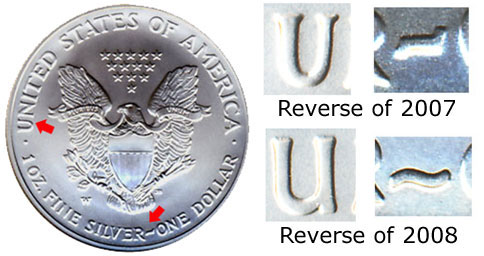
2008-W Silver Eagle Reverse of 2007 Variety
(Image courtesy of the Silver Eagle Guide)
The 1995-W
As part of the celebration of the 10th anniversary of the American Eagle program, the U.S. Mint created the 10th Anniversary American Eagle set. The set contained a 1995-W American Silver Eagle proof coin that was not made available to collectors not buying the set. Collectors wanting to purchase add the 1995-W American Silver Eagle proof coin to their collection had to purchase the entire five-coin set that included four American Gold Eagle proof coins ($5, $10, $25 and $50 gold American Eagles). The set was priced at $999 limiting the number of coins sold.Most of the sets have been split up to take advantage of the fluctuating metal prices. The gold coins have been sold while the gold prices rose since 1995, but the limited availability has caused the 1995-W American Silver Eagle to rise significantly on the secondary market. Cost to purchase this coin averages about $5,000, depending on the grade. Finding the entire set with the American Gold Eagle coins in their original government package can set you back $8,000 and higher.
Special Sets
In 1993, the U.S. Mint offered The Philadelphia Set, which was issued to commemorate the 200th anniversary of the striking of the first official U.S. coins at the Philadelphia Mint. This special set included each of the Proof American Gold and Silver Eagles struck at the Philadelphia Mint and containing the “P” mint mark. The 1993-P Proof Silver Eagle was included in the set along with the one-half ounce, one-quarter ounce, and one-tenth ounce 1993-P Proof Gold Eagles. Also included was a silver Philadelphia Bicentennial Medal, which specially produced for this numismatic product.
To mark the launch of the new American Platinum Eagle bullion and collector coin series, the US Mint offered the 1997 Impressions of Liberty Set. This set contained the one ounce 1997-W Proof Platinum Eagle, one ounce 1997-W Proof Gold Eagle, and one ounce 1997-P Proof Silver Eagle. Adding some special allure to the set, production was limited to just 5,000 units, which were individually numbered. The serial number for each set was engraved on a brass plate affixed to the wooden display case.
In 2004, the U.S. Mint worked with the United Kingdom’s Royal Mint to create a numismatic product containing the silver bullion coins from each country. The Legacies of Freedom Set contained one 2003 American Silver Eagle bullion coin and one 2002 British Silver Britannia bullion coin. The two coins were placed in special packaging which highlighted the importance of the two national icons.
To celebrate the 150th anniversary of the founding of the Bureau of Engraving and Printing and the 220th anniversary of the United States Mint the two bureaus joined together to release the 2012 Making American History Coin and Currency Set. The set contained a 2012-S American Silver Eagle Proof coin and a $5 note with a serial number beginning in “150”.
As part of the 2016 Ronald Reagan Coin and Chronicles Set the U.S. Mint included a 2016 Proof American Silver Eagle along with a 2016 Ronald Reagan Presidential reverse proof dollar, and a Nancy Reagan Bronze Medal. To complete the set, it included a presidential portrait produced by the Bureau of Engraving and Printing and an informational booklet.
Annual Sets
To extend the product line, the U.S. Mint began to create special annual issue sets to entice people to collect U.S. Mint products. The first annual set containing an American Silver Eagle coin was the Annual Uncirculated Dollar Coin Set. First offered in 2007, the set includes the issued uncirculated Presidential dollar coins, an uncirculated Native American dollar coin, and an uncirculated American Silver Eagle. Since the Presidential Dollar Program ended in 2016, it is unclear whether the U.S. Mint will issue the set in 2017.
Since 2012, the U.S. Mint has been producing the Limited Edition Silver Proof Set that contains 90% silver versions of the year’s five America the Beautiful Quarters, Kennedy Half Dollar, and Roosevelt Dime, along with the standard annual Proof American Silver Eagle. Sets are limited to 50,000 units annually.
Starting in 2013, the U.S. Mint has been producing the Congratulations Set as part of a new line of products targeted towards gift giving occasions. The This set included the standard annual Proof Silver Eagle within specially designed packaging which allowed a personalized message to be written the recipient.
Anniversary Sets
Since the American Eagle Program has been one of the most successful programs in the history of the U.S. Mint, they have used its popularity to extend the product line. Aside from celebrating the anniversary of the program, the U.S. Mint has produced anniversary sets to celebrate Mint facilities.The Anniversary sets issued are as follows:
- 1995 American Eagle 10th Anniversary Set included a 1995-W American Silver Eagle Proof coin and four American Gold Eagle coins.
- 2006 20th Anniversary American Silver Eagle Set was a special three-coin box set included a 2006-W American Silver Eagle with a burnished (satin) finish, a 2006-W American Silver Eagle Proof coin, and a 2006-P American Silver Eagle Reverse Proof coin.
- 2011 25th Anniversary American Silver Eagle Set was a five-coin box set that contained five different coins. The U.S. Mint produced only 100,000 sets that sold out within the first 10 minutes they were offered online. This extremely popular set is averaging $800 on the secondary market in the original government package. The set includes the following coins:
- 2011-W (West Point) American Silver Eagle Uncirculated coin
- 2011-S (San Francisco) American Silver Eagle Uncirculated coin
- 2011-W (West Point) American Silver Eagle Proof coin
- 2011-P (Philadelphia) American Silver Eagle Reverse Proof coin
- 2011 (no mintmark) American Silver Eagle Bullion coin
- 2012 American Eagle San Francisco Two Coin Silver Proof Set was issued to celebrate the 75th anniversary of the current San Francisco Mint. The set included a 2012-S American Silver Eagle Proof coin and a 2012-S American Silver Eagle Reverse Proof Coin.
- 2013 West Point American Silver Eagle Set was issued to celebrate the 75th anniversary of the facility in West Point, New York. The set included a 2013-W American Silver Eagle Reverse Proof coin and a 2013-W American Silver Eagle Enhanced Uncirculated coin. This was a popular set since it was the first appearance of the Enhanced Uncirculated finishing process.
Although the U.S. Mint did not issue a set to celebrate the 30th Anniversary of the American Silver Eagle in 2016, the collector issues of the coins were issued with special edge lettering. Rather than the edge being reeded it was smooth with “30TH ANNIVERSARY” struck into the edge. Both the proof and burnished uncirculated coins were produced at West Point include the “W” mintmark and the edge lettering.
Rolls and the Green Monster Box
When the U.S. Mint sells bullion coins to their authorized resellers, the coins are packaged in 20-coin hard plastic rolls and 25 rolls are placed in a specially designed box that contains 500 troy ounces of silver. Because the box is green in color and sealed by the U.S. Mint, the package is nicknamed the Green Monster Box.
Resellers sell Green Monster Boxes with the intent of selling to investors. They also sell complete rolls from the Monster Box.
Sealed Green Monster Boxes have the benefit of being unsearched and unhandled since leaving the U.S. Mint. Additionally, the cost per coin is usually the lowest available since the coins are being purchased in bulk. These boxes are usually offered for sale by bullion dealers at a small premium over the current market (spot) price of silver.
In the next installment, we look at the American Gold Eagle coins.
Weekly World Numismatic News for September 16, 2018
Rather than the coin machines, the lanes will be converted to “E-ZPass Only” lanes.
Although I am a proponent of cash, E-ZPass has been a blessing when traveling in the northeast. When I started a somewhat regular drive between the D.C. area and northern New Jersey, where my first wife is resting, I applied for the New Jersey E-ZPass. It made driving to the New York area easier by not having to stop for tolls.
Then there were the advances that allowed the New Jersey Turnpike to allow the use of E-ZPass before Maryland finally joined the party. Soon I was able to drive from Maryland to Maine without having to stop and pay a toll.
Long gone were the days where I planned a trip with a pocket full of quarters. Or when I was commuting to New Jersey from New York, buying a $20 roll of ten Triborough Bridge and Tunnel Authority tokens to cross the Verrazano-Narrows Bridge from Brooklyn to Staten Island. The one-way toll on the Verrazano Bridge was $5.00 or two tokens.
For the return home, there was a discount coupon book I bought every two weeks from the Port Authority to pay for crossing either the Goethals Bridge or the Outerbridge Crossing.
Both bridges provide a toll discount for using E-ZPass. Given the nature of traffic, it is easier to get through the toll plaza with the E-ZPass.
I will continue to use cash more than my credit card but I will not give up my E-ZPass.
And now the news…
Hundreds of ancient Roman gold coins have been discovered on the site of an old theatre in Como in northern Italy, the Ministry of Culture said.  → Read more at thelocal.it
→ Read more at thelocal.it
Ultimately a judge did not have to decide which mint was in the right. The case was dismissed after they agreed to a ‘collaborative’ cross-licensing agreement  → Read more at nationalpost.com
→ Read more at nationalpost.com
Plans to sell them as ‘sacred coins’ to non-resident Telugu society  → Read more at thehindubusinessline.com
→ Read more at thehindubusinessline.com
Mike Alessia chuckled when he thought about the days before E-Z Pass and paying your way down the Garden State Parkway doubled as a skill sport.  → Read more at pressofatlanticcity.com
→ Read more at pressofatlanticcity.com
Madurai: An ancient coin, dating back to the 14th century was discovered near Palani recently.  → Read more at timesofindia.indiatimes.com
→ Read more at timesofindia.indiatimes.com
A drop in silver prices this year has attracted investors seeking a bargain, prompting a temporary sellout of the 2018 American Silver Eagle bullion coins at the U.S. Mint this month.  → Read more at marketwatch.com
→ Read more at marketwatch.com
The battle to end taxation of constitutional money has reached the federal level as U.S. Representative Alex Mooney (R-WV) today introduced sound money legislation to remove all federal income taxation from gold and silver coins and bullion.  → Read more at moneymetals.com
→ Read more at moneymetals.com
LOOK BACK: Defence of Fort McHenry

Fort McHenry (via Wikipedia)
On Skinner’s way to meet Vice Admiral Alexander Cochrane, Rear Admiral Sir George Cockburn, and Major General Robert Ross on the HMS Tonnant, he stopped at the home of noted lawyer Francis Scott Key and asked for his assistance.
Col. Skinner and Key were welcomed by the British command on September 13, 1814 and was invited to stay for dinner. After secure the release of Dr. Beanes but were not allowed to return to Baltimore. The British felt that Col. Skinner and Key had learned too much about the British forces. Col. Skinner, Key, and Dr. Beanes were provided guest accommodations on the HMS Tonnant.
The Battle of Baltimore began after dinner and raged overnight through the next morning. On September 14, 1814, when the smoke cleared, Key saw the Stars and Stripes still flying over Fort McHenry. Following the battle. Col. Skinner, Key, and Dr. Beanes were allowed to return to Baltimore on their own boat. During the trip, Key wrote a poem entitled “The Defence of Fort McHenry”
On September 20, 1814, Key had the poem published in the newspaper Patriot. After publication, Key set the poem to the tune of John Stafford Smith’s “The Anacreontic Song,” a popular drinking song written for London’s Anacreontic Society. The combination was renamed “The Star Spangled Banner.”
“The Star Spangled Banner” was first recognized by the Navy in 1889. In 1916, President Woodrow Wilson signed an executive order to recognize “The Star-Spangled Banner” as the national anthem. Finally, President Herbert Hoover singed a congressional bill officially making the song the United State’s National Anthem (36 U.S.C. §301).
In 2012, the U.S. Mint issued two coins as part of the Star-Spangled Banner Commemorative Coin Program (authorized by Public Law 111-232). The $5 gold coin “depicts a naval battle scene from the War of 1812, with an American sailing ship in the foreground and a damaged and fleeing British ship in the background” on the obverse and “the first words of the Star-Spangled Banner anthem, O say can you see, in Francis Scott Key’s handwriting against a backdrop of 15 stars and 15 stripes, representing the Star-Spangled Banner flag.”
- 2012 Star-Spangled Banner Gold Commemorative Obverse depicts a naval battle scene from the War of 1812, with an American sailing ship in the foreground and a damaged and fleeing British ship in the background. Designed by Donna Weaver and engraved by Joseph Menna.
- 2012 Star-Spangled Banner Gold Commemorative Reverse Depicts the first words of the Star-Spangled Banner anthem, O say can you see, in Francis Scott Key’s handwriting against a backdrop of 15 stars and 15 stripes, representing the Star-Spangled Banner flag. Designed by Richard Masters and engraved by Joseph Menna.
The obverse of the silver $1 coin “depicts Lady Liberty waving the 15-star, 15-stripe Star-Spangled Banner flag with Fort McHenry in the background.” The reverse shows the waving of a modern American Flag.
- 2012 Star-Spangled Banner Silver Commemorative Obverse depicts Lady Liberty waving the 15-star, 15-stripe Star-Spangled Banner flag with Fort McHenry in the background. Designed by Joel Iskowitz and engraved by Phebe Hemphill.
- 2012 Star-Spangled Banner Silver Commemorative Reverse depicts a waving modern American flag. Designed by William C. Burgard III and engraved by Don Everhart.
The official launch of the 2012 Star-Spangled Banner Commemorative Coin Program was launched at Fort McHenry in Baltimore. You can read about that launch here.




